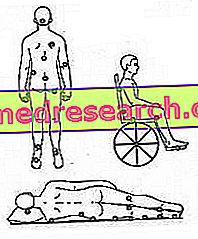What is alvo?
The term "alvo" indicates the intestinal canal as a whole and the function of defecation . Therefore, the alterations of various nature that affect the patient can occur with irregularities and changes in the frequency or quality of the evacuation.

In any case, if they last for a long time, alterations of the hook can cause serious problems. For this reason, it is important to tackle the causes of malaise and malfunctioning with a suitable therapeutic approach.
Alvo Regular
We talk about regular alvo (or normally canalised, that is open to faeces, liquids and gases) when there are no imbalances in intestinal function and the methods of eliminating faeces are not altered.
It should be taken into account that this " intestinal regularity " varies greatly from person to person. In healthy adults, based on the proportion of non-absorbable substances contained in the diet, the quantity of faeces normally fluctuates between 100 and 300 grams per day.
Alvo Stitico
The constipated alvo is characterized by the slowing of the intestinal transit, with difficult or infrequent emission of feces or a decrease in the quantity of the latter.
The evacuation every 2-3 days can be considered normal, as long as there is no pain in the lower abdomen or general malaise. In fact, the constipated alvo can be a simple annoying disorder or the expression of more serious pathologies.
Constipation can occur due to stress, when one is traveling or if one is on a diet lacking in fiber. Other potential risk factors are irregular sleep-wake rhythms, the habit of drinking little and the tendency to postpone or suppress the urge to evacuate.
If it appears suddenly, a defecation from longer times must always make you think of an organic cause, such as a narrowing of the intestinal lumen of inflammatory origin or, more rarely, a benign tumor pathology (large polyps) or malignant (cancer at colon).
Chronic forms of constipated alvo are caused, instead, mainly by functional factors, such as the difficulty of rectal expulsion or the reduction of intestinal peristalsis. Certain drugs (including calcium channel blockers to control blood pressure or anti-depressants) can also promote the problem. To learn more, see the article on drugs that cause constipation.
The constipated alvo manifests itself with an evacuation frequency of less than three times a week, with the emission of hard, dry, difficult to expel, or when one's habits change over time. The disorder may be associated with symptoms such as abdominal swelling, heaviness and a feeling of insufficient evacuation. If chronic, the constipated alvo can favor the appearance of hemorrhoids, rectal prolapse and anal fissures, due to the effort to expel hard stools.
Constipated alvo in relation to aging
The constipated alvo is frequent in elderly people, due to the low fiber content of the diet, the reduction of physical activity, the coexistence of internal diseases, the lack of thirst and the use of drugs that favor the problem. Additional changes that predispose the elderly to constipation include poor excitability or rectosigmoid contractility; therefore, more rectal volumes are needed to trigger the defecation stimulus.
In children, on the other hand, the constipated alvo may be the consequence of the habit of postponing the act of defecation, by inhibiting the stimuli that invite the emptying of the rectum.
Aliar diarrheal
A diarrheal alvo means an evacuation characterized by liquid or stool-like stools, repeated throughout the day. This alteration can be due to numerous morbid forms, not necessarily dependent on the digestive system.
The diarrheal alvo may be a transient episode, attributable to an excess of food, an infection (eg viral gastroenteritis) or indigestion without serious consequences. In these cases, the disorder can be associated with other manifestations, such as swelling, abdominal pain, nausea, vomiting and fever, but tends to disappear within a few days.
Repeated episodes of diarrhea mixed with mucus and blood with abdominal pain, especially at a young age, can instead represent the first symptom of a chronic inflammatory bowel disease, such as Crohn's disease or ulcerative colitis.
Diarrhea that lasts over time can lead to complications such as fluid loss resulting in dehydration and electrolyte depletion (such as sodium, potassium and magnesium). In very debilitated patients, severe diarrheal alvo can promote cardiovascular collapse.
Alvo closed to faeces
In some cases, alteration of the alve can become a surgical emergency. In fact, it may happen that the alvo is closed to the faeces, making only the expulsion of intestinal gases possible: this symptom can signal the presence of an obstruction (mechanical ileus) secondary to volvulus, hernias, adhesions or to masses that occupy the lumen of the enteric tract, such as fecal impaction, tumors or abscesses.
The alvo can be closed both to the faeces and to the gases (paralytic ileum) also in response to certain abdominal inflammatory pathologies, such as peritonitis, diverticulitis and pelvic inflammatory disease.
Associated symptoms
Irregularities of the alvo (diarrhea and / or constipation) can occur with:
- Increase or decrease in the frequency of evacuations (eg less than three per week or more than three per day);
- Change in color and consistency of stools;
- Impellent urge to evacuate (incontinence) or difficult defecation associated with severe pain (tenesmus);
- Intermittent abdominal pains, in the form of cramps, with variable intensity and location;
- Flatulence, meteorism and feeling of swelling.
Other symptoms that may accompany alterations of the alve include:
- Headache;
- Pelvic pain and back pain;
- Fatigue and poor performance;
- Sleep disorders;
- Menstrual cramps;
- Depression and anxiety;
- Sense of general malaise.
Signals to be reckoned with
If the following symptoms appear, it is important to contact your doctor to identify the cause and practice the most appropriate therapy:
- Acute abdominal pain;
- Nausea and vomit;
- Constipation with sudden onset with interruption of the transit of feces and gas;
- Faecal retention for more than three days by children;
- Signs of dehydration;
- Presence of blood or pus in the faeces;
- Small, hard and compressed stools (fecalomas or coprolites);
- Unexplained weight loss.
Alve alterations: Main causes
A malfunction of the hook can be the consequence of transitory situations, such as:
- Stress periods;
- Modification of eating habits (for example: meals hurriedly consumed or too abundant, excess of sugary and carbonated drinks, diet low in fruit and vegetables and too rich in sugar and fat, dehydration and poor food hygiene).
- Laxative abuse
Alve alterations may also depend on numerous diseases, including:
- Food poisoning;
- Lactose intolerance (contained, for example, in milk, ice cream, yogurt and soft cheese);
- Allergies;
- Malabsorption syndromes (including celiac disease and Whipple's disease);
- Pancreatic insufficiency;
- Diverticulitis;
- Diabetes;
- Systemic lupus erythematosus;
- Intestinal polyps;
- Scleroderma;
- Multiple sclerosis;
- Inflammatory bowel disease (ulcerative colitis and Crohn's disease);
- Irritable bowel syndrome
- Adrenal insufficiency;
- Cystic fibrosis;
- Endometriosis;
- Psychiatric disorders;
- Neoplastic processes (including colorectal, anus and ovarian cancer).
Alvo alterations can also result from some oncological therapies (radio- and chemotherapy), surgical (bypass and intestinal or gastric resections) and pharmacological therapies (eg antacids containing magnesium, selective serotonin re-uptake inhibitors, colchicine, quinine / quinidine and prostaglandin analogues).
Diagnosis
In the event of alterations of the alv, it is advisable to undergo a thorough examination by the gastroenterologist, who will investigate the disorder to identify the causes.
The diagnostic path involves, first of all, the collection of anamnestic data, with particular attention to the characters of the alterations of the hoar: circumstances of onset (including recent trips and ingested food), duration and severity of the episode, frequency of evacuations, use of drugs, associated symptoms (eg abdominal pain or vomiting), changes in the color or consistency of the stools, changes in body weight or appetite and possible presence of urgency or rectal tenesmus (painful abdominal cramp, with ineffective evacuation efforts). In addition, a complete physical examination is indicated, with attention to the abdomen and rectal exploration to assess sphincter function.
In the event that the alteration of the alvus is accompanied by a series of severe diarrheal episodes or a blockage of defecation, it is necessary to undergo further tests in a timely manner (such as laboratory tests, ultrasound, colonoscopy, X-rays and CT scans) to identify the underlying pathological condition and to establish the most suitable treatment for the specific case.
The instrumental and laboratory investigations allow to find in the fecal material food residues, evidence of steatorrhea, microscopic and macroscopic blood, mucus and parasites. The rectus-colonoscopy allows us to highlight any lesions of the enteric tract, such as diverticula, polyps and carcinoma.
Treatment and Advice
Treatment depends on the cause of the alteration of the alvus.
In various situations, however, the recovery of a more active lifestyle and the correction of eating habits suffice to solve the problem. The doctor can provide specific advice on this: in cases of stubborn constipation, it could indicate, for example, the intake of laxatives or prokinetic drugs; in diarrheal forms, however, it could suggest the use of probiotics or antidiarrheal.
Drink a lot during the day.
To restore correct bowel function, you need to take at least 8 glasses of liquids every day - choosing from water, diluted fruit juices, barley or decaffeinated coffee or tea - preferably at room temperature, rather than very hot or cold. Instead, alcoholic, sweet or carbonated drinks should be limited.
What to eat and what to avoid. Alvo alterations can be cured with a balanced diet, chewing calmly and for a long time.
- In case of diarrheal alvo, take small and frequent meals during the day, choosing foods such as rice, crackers, rusks, pasta and bread made of white flour. Among the vegetables, prefer potatoes, carrots or zucchini and tomato sauce without peel and seeds. To learn more: Diet for Diarrhea.
- In the case of constipated alvo, consume 4-5 portions a day of raw or cooked fruit and vegetables. Take 2-3 times a week legumes (chickpeas, beans, lentils, peas and soy) and prefer whole grains and derivatives (bread, pasta, rice, biscuits and breadsticks). Even yogurt, thanks to lactic ferments, can be advantageously exploited against constipation. To learn more: Diet for constipation
Practice regular physical activity.
In the presence of alterations of the alvo not complicated by organic diseases, one should increase daily physical activity: moving more means helping peristalsis (ie the set of involuntary movements that the intestine performs to facilitate the descent and expulsion of the I.). Generally, it is sufficient to walk briskly as soon as possible, at least 40 minutes each day.



